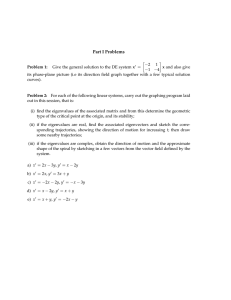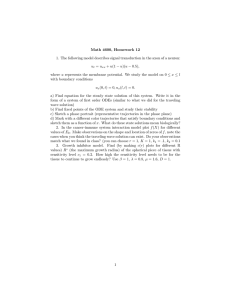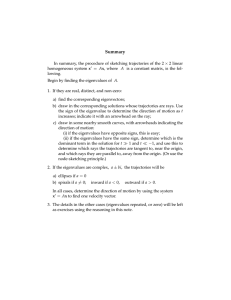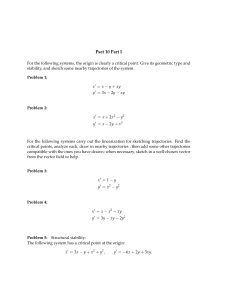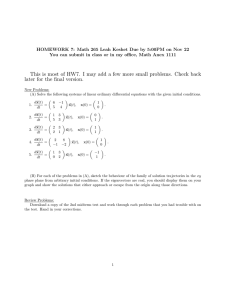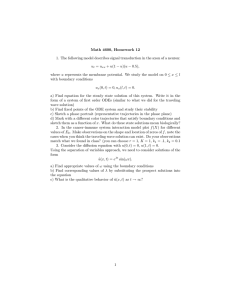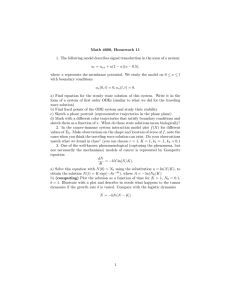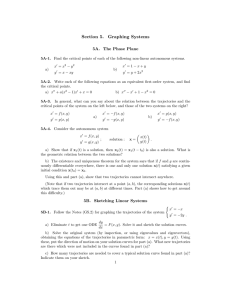Document 13691748
advertisement
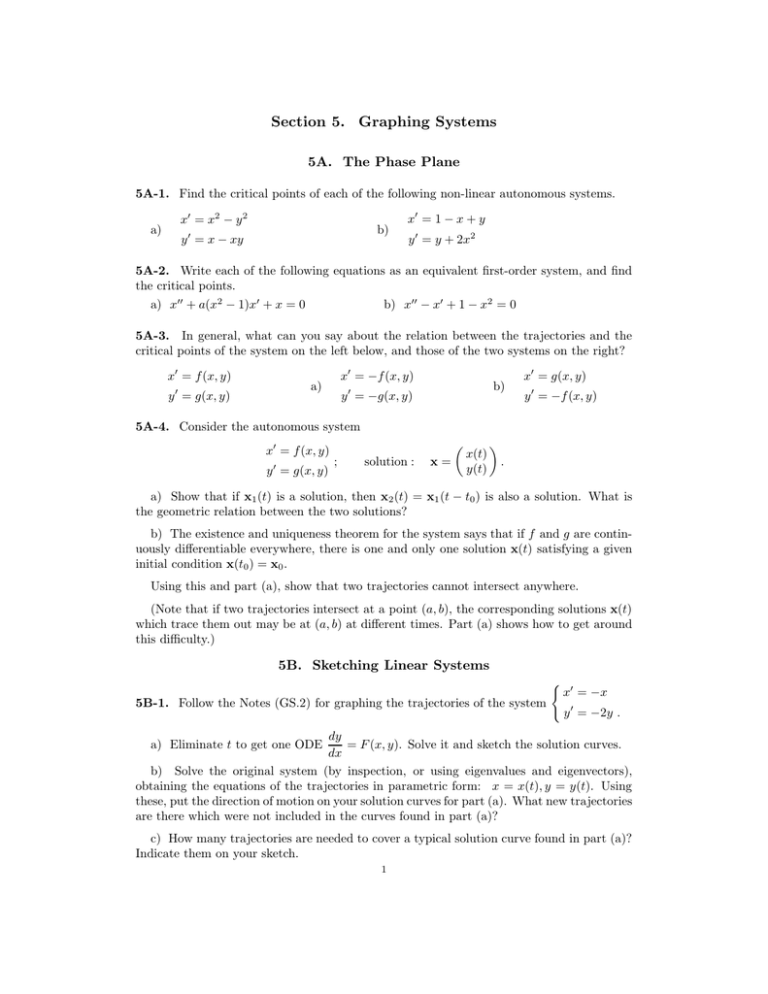
Section 5. Graphing Systems 5A. The Phase Plane 5A-1. Find the critical points of each of the following non-linear autonomous systems. a) x� = x 2 − y 2 b) y � = x − xy x� = 1 − x + y y � = y + 2x2 5A-2. Write each of the following equations as an equivalent first-order system, and find the critical points. a) x�� + a(x2 − 1)x� + x = 0 b) x�� − x� + 1 − x2 = 0 5A-3. In general, what can you say about the relation between the trajectories and the critical points of the system on the left below, and those of the two systems on the right? x� = f (x, y) y � = g(x, y) x� = −f (x, y) a) b) y � = −g(x, y) x� = g(x, y) y � = −f (x, y) 5A-4. Consider the autonomous system x� = f (x, y) y � = g(x, y) ; solution : x= � x(t) y(t) . a) Show that if x1 (t) is a solution, then x2 (t) = x1 (t − t0 ) is also a solution. What is the geometric relation between the two solutions? b) The existence and uniqueness theorem for the system says that if f and g are contin­ uously differentiable everywhere, there is one and only one solution x(t) satisfying a given initial condition x(t0 ) = x0 . Using this and part (a), show that two trajectories cannot intersect anywhere. (Note that if two trajectories intersect at a point (a, b), the corresponding solutions x(t) which trace them out may be at (a, b) at different times. Part (a) shows how to get around this difficulty.) 5B. Sketching Linear Systems 5B-1. Follow the Notes (GS.2) for graphing the trajectories of the system � x� = −x y � = −2y . dy = F (x, y). Solve it and sketch the solution curves. dx b) Solve the original system (by inspection, or using eigenvalues and eigenvectors), obtaining the equations of the trajectories in parametric form: x = x(t), y = y(t). Using these, put the direction of motion on your solution curves for part (a). What new trajectories are there which were not included in the curves found in part (a)? a) Eliminate t to get one ODE c) How many trajectories are needed to cover a typical solution curve found in part (a)? Indicate them on your sketch. 1 2 18.03 EXERCISES d) If the system were x� = x, y � = 2y instead, how would your picture be modified? (Consider both parts (a) and (b).) 5B-2. Answer the same questions as in 5B-1 for the system (d), use −y and −x as the two functions on the right.) x� = y, y � = x. (For part 5B-3. Answer the same question as in 5B-1a,b for the system x� = y, y � = −2x. For part (b), put in the direction of motion on the curves by making use of the vector field corresponding to the system. 5B-4. For each of the following linear systems, carry out the graphing program in Notes GS.4; that is, (i) find the eigenvalues of the associated matrix and from this determine the geometric type of the critical point at the origin, and its stability; (ii) if the eigenvalues are real, find the associated eigenvectors and sketch the corre­ sponding trajectories, showing the direction of motion for increasing t; then draw in some nearby trajectories; (iii) if the eigenvalues are complex, obtain the direction of motion and the approximate shape of the spiral by sketching in a few vectors from the vector field defined by the system. a) d) x� = 2x − 3y y � = x − 2y x� = x − 2y y� = x + y b) e) x� = 2x y � = 3x + y c) x� = −2x − 2y y � = −x − 3y x� = x + y y � = −2x − y 5B-5. For the damped spring-mass system modeled by the ODE mx�� + cx� + kx = 0, m, c, k > 0 , a) write it as an equivalent first-order linear system; b) tell what the geometric type of the critical point at (0, 0) is, and determine its stability, in each of the following cases. Do it by the methods of Sections GS.3 and GS.4, and check the result by physical intuition. (i) c = 0 (ii) c � 0; m, k � 1. (iii) Can the geometric type be a saddle? Explain. 5C. Sketching Non-linear Systems 5C-1. For the following system, the origin is clearly a critical point. Give its geometric type and stability, and sketch some nearby trajectories of the system. x� = x − y + xy y � = 3x − 2y − xy 5C-2. Repeat 5C-1 for the system � x� = x + 2x2 − y 2 y � = x − 2y + x3 SECTION 5. GRAPHING SYSTEMS � 5C-3. Repeat 5C-1 for the system 3 x� = 2x + y + xy 3 y � = x − 2y − xy 5C-4. For the following system, carry out the program outlined in Notes GS.6 for sketching trajectories — find the critical points, analyse each, draw in nearby trajectories, then add some other trajectories compatible with the ones you have drawn; when necessary, put in a vector from the vector field to help. x� = 1 − y y � = x2 − y 2 � 5C-5. Repeat 5C-4 for the system x� = x − x2 − xy y � = 3y − xy − 2y 2 5D. Limit Cycles 5D-1. In Notes LC, Example 1, a) Show that (0, 0) is the only critical point (hint: show that if (x, y) is a non-zero critical point, then y/x = −x/y; derive a contradiction). b) Show that (cos t, sin t) is a solution; it is periodic: what is its trajectory? c) Show that all other non-zero solutions to the system get steadily closer to the solution in part (b). (This shows the solution is an asymptotically stable limit cycle, and the only periodic solution to the system.) 5D-2. Show that each of these systems has no closed trajectories in the region R (this is the whole xy-plane, except in part (c)). a) d) x� = x + x 3 + y 3 y � = y + x3 + y 3 b) x� = ax + bx2 − 2cxy + dy 2 � 2 y = ex + f x − 2bxy + cy 2 : x� = x 2 + y 2 y� = 1 + x − y x� = 2x + x2 + y 2 c) y � = x2 − y 2 R = half-plane x < −1 find the condition(s) on the six constants that guarantees no closed trajectories in the xy-plane 5D-3. Show that Lienard’s equation (Notes LC, (6)) has no periodic solution if either a) u(x) > 0 for all x b) v(x) > 0 for all x . (Hint: consider the corresponding system, in each case.) 5D-4.* a) Show van der Pol’s equation (Notes LC.4) satisfies the hypotheses of the Levinson-Smith theorem (this shows it has a unique limit cycle). b) The corresponding system has a unique critical point at the origin; show this and determine its geometric type and stability. (Its type depends on the value of the parameter). � 5D-5.* Consider the following system (where r = x2 + y 2 ): x� = −y + xf (r) y � = x + yf (r) 4 18.03 EXERCISES a) Show that if f (r) has a positive zero a, then the system has a circular periodic solution. b) Show that if f (r) is a decreasing function for r � a, then this periodic solution is actually a stable limit cycle. (Hint: how does the direction field then look?) SECTION 5. GRAPHING SYSTEMS 5 5E. Structural stability; Volterra’s Principle 5E-1. Each of the following systems has a critical point at the origin. For this critical point, find the geometric type and stability of the corresponding linearized system, and then tell what the possibilities would be for the corresponding critical point of the given non-linear system. a) x� = x − 4y − xy 2 , y � = 2x − y + x2 y b) x� = 3x − y + x2 + y 2 , y � = −6x + 2y + 3xy 5E-2. Each of the following systems has one critical point whose linearization is not structurally stable. In each case, sketch several pictures showing the different ways the trajectories of the non-linear system might look. Begin by finding the critical points and determining the type of the corresponding lin­ earized system at each of the critical points. a) x� = y, y � = x(1 − x) b) x� = x2 − x + y, y � = −yx2 − y 5E-3. The main tourist attraction at Monet Gardens is Pristine Acres, an expanse covered with artfully arranged wildflowers. Unfortunately, the flower stems are the favorite food of the Kandinsky borer; the flower and borer populations fluctuate cyclically in accordance with Volterra’s predator-prey equations. To boost the wildflower level for the tourists, the director wants to fertilize the Acres, so that the wildflower growth will outrun that of the borers. Assume that fertilizing would boost the wildflower growth rate (in the absence of borers) by 25 percent. What do you think of this proposal? Using suitable units, let x be the wildflower population and y be the borer population. Take the equations to be x� = ax − pxy, constants. y � = −by + qxy, where a, b, p, q are MIT OpenCourseWare http://ocw.mit.edu 18.03 Differential Equations �� Spring 2010 For information about citing these materials or our Terms of Use, visit: http://ocw.mit.edu/terms.
